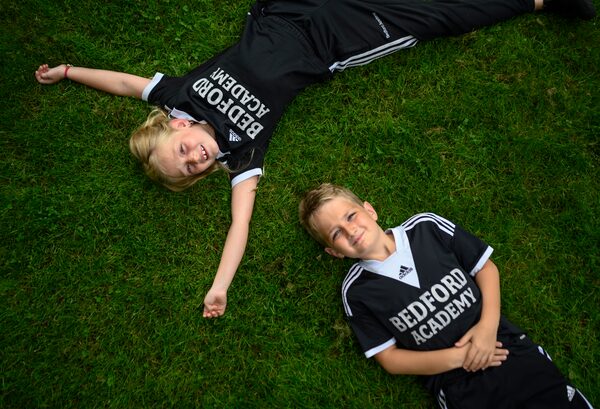
Alexander and Sophia Kerr-Gibbons, who attend Bedford Academy in Bedford, N.S., each have their own learning styles, and have excelled in the small class sizes the school offers.Darren Calabrese/The Globe and Mail
When Jennifer Kerr-Gibbons’ two children were ready to start school, she worried their needs wouldn’t be met in the average 25-plus-student classes at her local public school in suburban Halifax.
Her son Alexander was a wallflower who didn’t get any attention throughout his early childhood learning. Her daughter Sophia, on the other hand, is talkative and outgoing. Kerr-Gibbons feared that in a large classroom environment, where the teacher’s attention is pulled in many different directions, Alexander would be overlooked and Sophia would be labeled a “bad kid.”
“Everybody’s different – not everybody focuses the same way, they don’t learn the same way,” Kerr-Gibbons says. “You have to have time to figure that out, but if your head is turning in 30 different ways, you don't have time to see all those kids.”
It’s for this reason that she and her husband chose to send Alexander and Sophia to Bedford Academy, a private school in Bedford, N.S., with classes that top out at 18.
Kerr-Gibbons says Sophia, who is in Grade 2, has become a strong, confident child who learned to control herself in difficult situations. And with a little extra attention in the classroom, she also noticed a “huge change” in Alexander. He started to gain self-confidence and develop into his “own cool little person,” she says.
In the smaller classrooms their private school affords, “everybody gets noticed and everybody gets equal attention,” Kerr-Gibbons says.

Small class sizes are proven to have the greatest impact on the learning abilities of students ages six to 14, like Alexander and Sophia Kerr-Gibbons.DARREN CALABRESE/The Globe and Mail
The debate over class size has raged across the country this past year after the Ontario government announced it would increase the average class by one student in Grades 4 to 8, and by six students in high school – eliminating an estimated 3,475 teaching positions by the 2022-2023 school year as it tries to trim a deficit it pegs at $11.7-billion.
In academic institutions, class size is still a live policy debate. There is clear research that shows smaller class sizes have a positive impact in the early years of schooling, especially for minorities and low-achieving students, according to research on class sizes by the Goldman School of Public Policy at the University of California, Berkeley. According to research published in graduate journal PolicyMatters, there is the strongest evidence that small class sizes have the greatest impact on the learning abilities of those ages six to 14.
Private and independent schools are often sought-after by parents for their smaller classes, but the teachers in charge of them point out that quality education is more about the teacher and makeup of the class than class size.
At the Halifax Grammar School, a co-educational day school in Halifax, class size is one of the first questions parents ask when they’re inquiring about the school, learning strategist and former prep school head Linden Gray says.
But according to Gray, what’s more important than class size, which the Halifax Grammar School caps at 20, is the skill of the teacher.
Gray says the school’s teachers typically organize students into groups based on learning level in order to reach each one where they’re at. If there are exceptional learners in the classroom, such as children with learning disabilities or behavioural issues, it’s important that they have a small teacher-to-student ratio, otherwise the children who are capable often don’t get any attention at all.
“Their needs are not well met or as well met as they could be,” Gray says.
Rosseau Lake College in Rosseau, Ont., is the smallest accredited boarding school in Canada, with 100 students between grades 7 and 12, and class sizes range from two to 22. But more important than class size and minutes spent in the classroom are the relationships students cultivate with their teachers, says Rosseau Lake College head, Dr. Robert Carreau.
“We use small class sizes as a proxy for what we are really talking about, and that’s meaningful connections between adults and kids,” Carreau says, noting that the school has a mandate to provide individualized learning and hands-on education with a focus on the environment and the outdoors.
He adds that while some learners can make those connections at a desk during math class, it happens for others during outdoor activities, such as on a canoe trip, rock climbing or sleeping overnight in a snow quinzhee.
“Our outdoor programming is not just a cute way to enjoy Muskoka,” Carreau says. “It’s a critical part of our strategy to get teachers and students in situations in challenging experiences where they need to trust each other.”
“Throughout the year, the relationship becomes more of a trusting bond.”
Teeny tiny schools
Microschools are reimagined 21st-century one-room school houses. Think millennial Anne of Green Gables minus the chalkboard writing tablet and pinafore. They’re a mixture of homeschooling and private schooling, usually with a focus on technology and a student-driven curriculum. Microschools focus on developing each child’s own unique abilities and strengths. In Toronto, the Summit Micro School has 60 students and an average class size of 10 to 12.